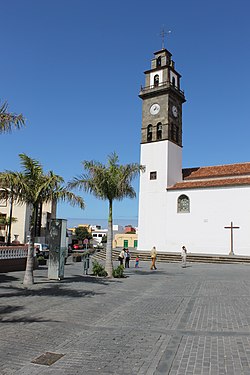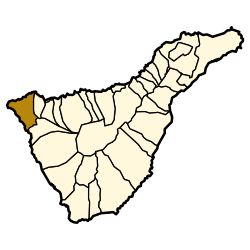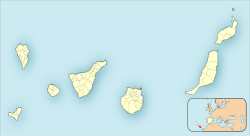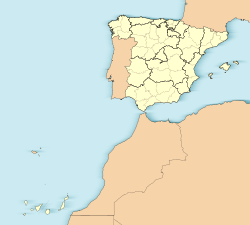Buenavista del Norte
This articlecontains wording thatpromotesthe subject throughexaggerationofunnoteworthy facts.(July 2024) |
Buenavista del Norte | |
|---|---|
Municipalityand town | |
 Main square: Nuestra Señora de Los Remedios | |
 Municipal location in Tenerife | |
| Coordinates:28°22′12″N16°51′0″W/ 28.37000°N 16.85000°W | |
| Country | |
| Autonomous Region | Canary Islands |
| Province | Santa Cruz de Tenerife |
| Island | Tenerife |
| Government | |
| • Alcade (Mayor) | Eva García (PSOE) |
| Area | |
| • Total | 67.42 km2(26.03 sq mi) |
| Population (2018)[1] | |
| • Total | 4,755 |
| • Density | 71/km2(180/sq mi) |
| Time zone | UTC+0(GMT) |
| Post Code | 38480 |
| Website | www.buenavistadelnorte.com |

Buenavista del Norteis a municipality and town on the north west coast ofTenerife,located on route TF42, about 75 km west of the capitalSanta Cruz de Tenerife,65 km fromTenerife North Airportand 66 km fromTenerife South Airport.
The towns streets show the sober architecture of clearly Andalusian extraction. Nevertheless, apart from the influence of the Conquistadors, there is a mixture of the traditions of Portuguese inhabitants and of Guanches, as the pre-Hispanic natives were known, which have helped to make up the particular charm of this district. The people have, due to the scarcity of resources, been characterised by an unquenchable spirit of conservation, which has kept alive traditions such as craftwork in bone, wood, cane and straw from the local forests of the region.[2]
Geography
[edit]Location
[edit]The municipality of Buenavista del Norte is located at the extreme north west point of the island of Tenerife bordering with the municipalities ofLos Silosto the east andSantiago del Teideto the south. It is connected with the former by TF42 and with the latter by the spectacular, but curvy route ofMasca(at 650 m) TF436. The total surface spanned by the municipality is of 67.42 km2,just 3% of the surface of the entire island. The volcanic formation of theMacizo de Tenothat emerged over 7 million years ago constitutes the largest section of the territory.
Population Distribution
[edit]Most of the population (75%) lives in the capital town located in the lower part of the municipality known as Casco antiguo. Most of the remaining inhabitants reside in either El Palmar (9%) at 300–500 m above sea level on TF436 or further along the same road in Las Portelas (6%) at 650 M above sea level. Las Canteras counts another 5.5% of the population, while the remaining locations,Masca,Teo and Los Carrizales are sparsely populated. The villages of Masca, Teno Alto, Los Carrizales, El Palmar, Las Portelas and Las Lagunetas preserve the old agricultural traditions of Canary Islands while in the lower coastal part, the cultivation of bananas dominates.
Flora and Fauna
[edit]Coastal Vegetation
[edit]The bioclimatic coastal environment is classified as inframediterranean.[3]

The vegetation consists of both native and imported species that have established a symbiotic ecosystem whereby the invasive species may provide protection from human traffic, strong winds or water erosion for the native plant. This is exemplified that the high density growth ofPrickly pear cactusandbalsam spurgeknown locally as tabaiba. Both are abundant along the coastal region as close as 30 meters from the ocean, fromPunta Tenoto theBuenavista Lighthouseclose to the border withLos Silos.Also prominent because of its size isCanary Island spurge.Two varieties ofPatellifolia,patellaris and procumbens, are often found very close to the shore. Many of its characteristic resembleTetragonia tetragonoideswith which it shares a strong salt tolerance and mode of propagation. A few examples ofKleinia neriifoliacan be found close to the basaltic cliffs. It becomes more dominant further inland, abundant on the volcanic dome (with a crater that was converted into a reservoir, known as Embalse Montaña de Taco) south of theBuenavista Lighthouse.A variety ofArgyranthemum,(coronopifolium or adauctum[4]) is abundant, Asparagus pastorianus[5]is the majorasparagusvariety found along the coastal region. Astydamia latifolia[6]is easily recognized as a plant of thecelery familyby is characteristic fragrance similar toangelica.It is important in the seasonal parched to green transformation of the coastal landscape as it loses most its leaves during the dry period that sprout again from arizomeafter the first autumn rains. Large bushes of Salsola divaricata[7]remain predominantly green in the dry season flowering after the rains.Schizogyne sericeais ubiquitous forming large bushes with yellow flowers.Sea fennelrecognizable from its distinct smell and grey-green color of its succulent leaves, is found on the basaltic cliffs a few meters from the ocean but seldom inland more than 200 meters. Other common plants areEuphorbia aphylla,Hyoscyamus albus,Mesembryanthemum crystallinum,Monanthes laxiflora,[8]Nicotiana glauca,Periploca laevigata.
Climate
[edit]Buenavista del Norte has aMediterranean climate,with most rain falling from October to March. Its exposed northwesterly location allows it to trap most of the moisture condensed by the mountains of Tenerife, so that it receives over three times more rainfall than Santa Cruz de Tenerife.
| Climate data for Buenavista del Norte | |||||||||||||
|---|---|---|---|---|---|---|---|---|---|---|---|---|---|
| Month | Jan | Feb | Mar | Apr | May | Jun | Jul | Aug | Sep | Oct | Nov | Dec | Year |
| Mean daily maximum °C (°F) | 17.1 (62.8) |
17.0 (62.6) |
17.2 (63.0) |
17.3 (63.1) |
18.6 (65.5) |
19.9 (67.8) |
22.3 (72.1) |
23.1 (73.6) |
22.6 (72.7) |
21.5 (70.7) |
19.0 (66.2) |
17.3 (63.1) |
19.4 (66.9) |
| Mean daily minimum °C (°F) | 12.1 (53.8) |
11.5 (52.7) |
11.8 (53.2) |
11.9 (53.4) |
13.1 (55.6) |
14.4 (57.9) |
16.7 (62.1) |
17.7 (63.9) |
17.2 (63.0) |
16.5 (61.7) |
14.9 (58.8) |
13.0 (55.4) |
14.2 (57.6) |
| Averageprecipitationmm (inches) | 167 (6.6) |
95 (3.7) |
70 (2.8) |
18 (0.7) |
12 (0.5) |
9 (0.4) |
1 (0.0) |
3 (0.1) |
4 (0.2) |
90 (3.5) |
207 (8.1) |
122 (4.8) |
798 (31.4) |
| Source: Sistema de Clasificación Bioclimática Mundial[9] | |||||||||||||
References
[edit]- ^Municipal Register of Spain 2018.National Statistics Institute.
- ^webtenerife.co.uk
- ^Marcelino del-Arco PL, Pérez-de-Paz JR, Acebes JM, González-Mancebo, JA, Reyes-Betancort, JA, Bermejo S, González-González R (2006). "Bioclimatology and climatophilous vegetation of Tenerife (Canary Islands)".Annales Botanici Fennici.43(3): 167–192.
- ^See: http://www.floradecanarias.com/argyranthemum_adauctum.htmlFlora de Canarias
- ^See:http://www.floradecanarias.com/asparagus_pastorianus.htmlFlora de Canarias
- ^See:es:Astydamia latifolia[circular reference]
- ^See:es:Salsola divaricata[circular reference]
- ^See:http://www.floradecanarias.com/monanthes_laxiflora.html
- ^"Sistema de Clasificación Bioclimática Mundial. Buenavista, Tenerife".





